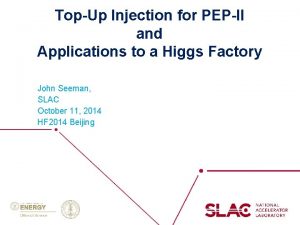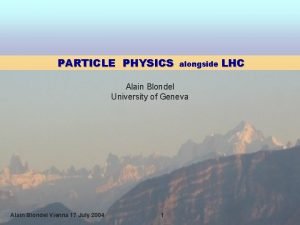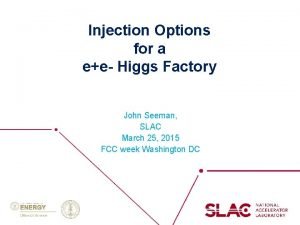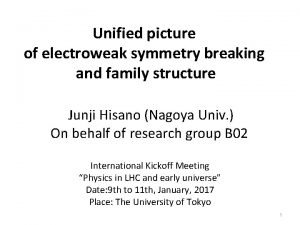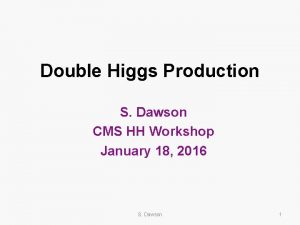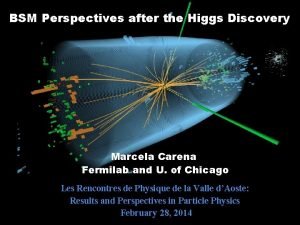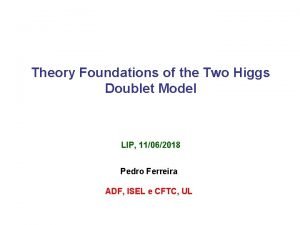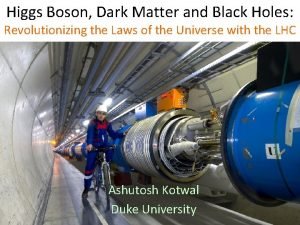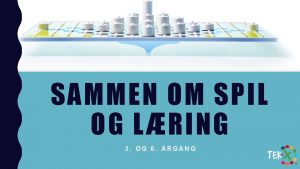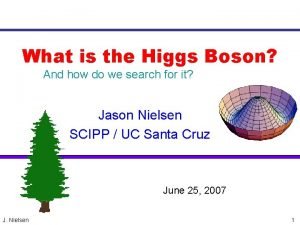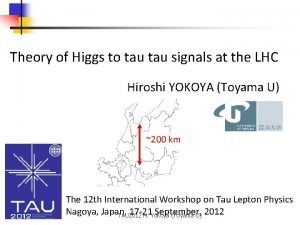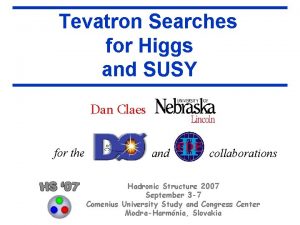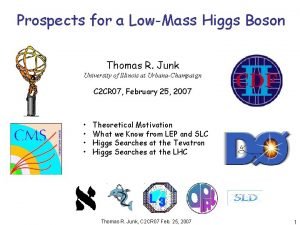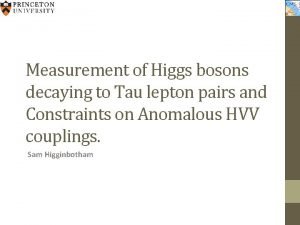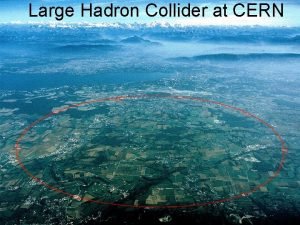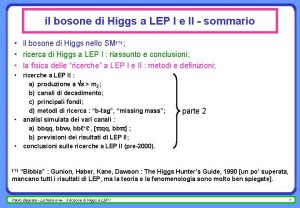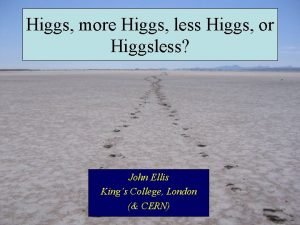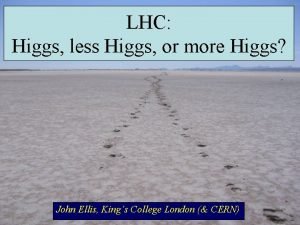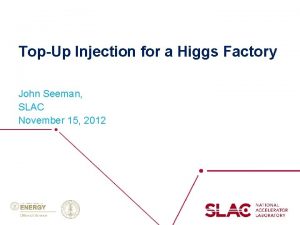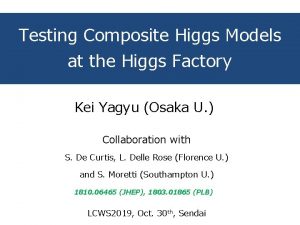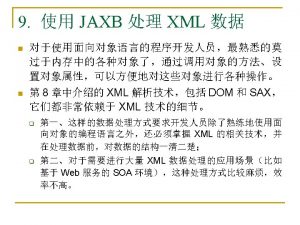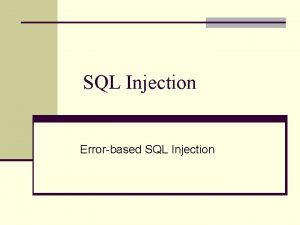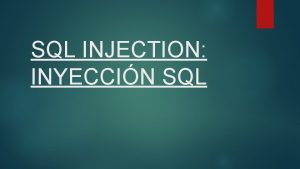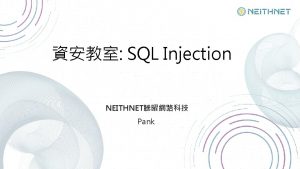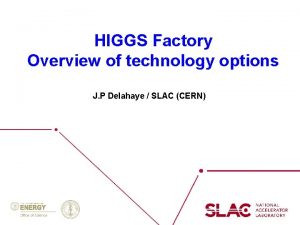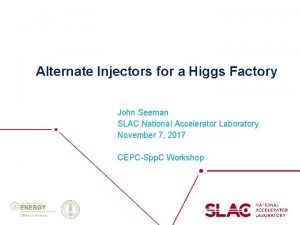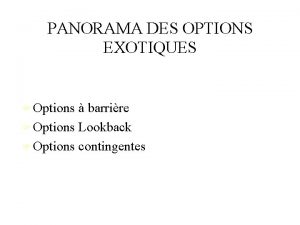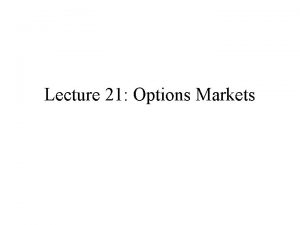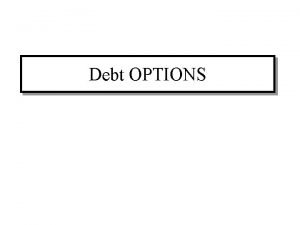Injection Options for a ee Higgs Factory John





















- Slides: 21

Injection Options for a e+e- Higgs Factory John Seeman, SLAC March 25, 2015 FCC week Washington DC

Topics for Injection for an e+e- Higgs Factory Required injection parameters for a Circular Higgs Factory Summary of the initial injector parameters “Storage ring style” injector “Fast cycling synchrotron” injector Detector masking 2

FCC-ee preliminary layout C=100 km ü ü consistent with FCC-hh layout RF staging scenario defined

preliminary FCC-ee parameters parameter FCC-ee LEP 2 energy/beam 45 – 175 Ge. V 105 Ge. V bunches/beam 50 – 60000 4 beam current 6. 6 – 1450 m. A 3 m. A hor. emittance ~2 nm ~22 nm emittance ratio ey/ey 0. 1% 1% vert. IP beta function by* 1 mm 50 mm luminosity/IP 1. 5 -280 x 1034 cm-2 s-1 0. 0012 x 1034 cm-2 s-1 energy loss/turn 0. 03 -7. 55 Ge. V 3. 34 Ge. V synchrotron radiation power 100 MW 23 MW RF voltage 0. 3 – 11 GV 3. 5 GV • Large number of bunches at Z and WW and H requires 2 rings. • High luminosity means short beam lifetime (few mins) and requires continuous injection (top up).

The CEPC Layout ½ RF RF IP 1 RF P. S. BTCe+ 8 arcs 5852. 8 m each ½ RF (4 IPs, 1132. 8 m each) BTCe- One collider RF station: Ø 650 MHz five-cell SRF cavities; Ø 4 cavities/module Ø 12 modules, 8 m each Ø RF length 120 m D = 17. 428 km IP 4 RF IP 2 RF C = 54. 752 km 4 arc straights 849. 6 m each RF • LTB IP 3 P. S. • RF P. S. • Linac ½ RF • One booster RF station: 1. 3 GHz 9 -cell SRF cavities; 8 cavities/module 4 modules, 12 m each RF length 48 m

CEPC Accelerator Parameters 6

CEPC Injector Parameters 7

Electron and Positron Production A Higgs Factory stores about 3 to 5 x 1013 e+ per ring. HF with 10 minute lifetime needs 1 to 3 x 1013 e-/e+ every 10 min or ~5 x 1010 e+ and e- per second at full energy. Past: CERN: LEP injection complex delivered ~1011 e+ per second. SLAC: SLC injection complex delivered ~6 x 1012 e+ per second. So a HF injector particle production should be straight forward. 8

Summary Injection Parameters Ring: 100 km 45 Ge. V: 60000 bunches at 5 x 1010 per bunch 175 Ge. V: 50 bunches at 2. 8 x 1011 per bunch Ring: 50 km 120 Ge. V: 50 bunches at 3. 7 x 1011 per bunch Injection: 50 bunches with ~7 x 109 per bunch at 0. 067 Hz (15 sec cycle) or 1000 bunches at ~109 per bunch at 0. 1 Hz (10 sec cycle) 9

Higgs Factory Injection Phase Space bx at injection septum (stored) = ~200 m Stored Beam Orbit Injection orbit Septum blade bx at injection septum (injection) = ~30 m exstored (stored) =6 nm Stored beam exinj (injected) =40 nm Injection bump on sxstored at septum (stored) = 1. 1 mm sxinj at septum (injected) = 1. 1 mm Injection bump xc Injected beam (+/- 2 sxinj) Xs = Septum blade thickness =~ 5 mm Xc = septum clearance distance = ~6 sx Xinj < Ax Ax Xinj = 4 sinj+Xs+Xc = ~16 mm xinj Injection bump off (~one turn later) Ax = machine aperture > ~20 mm xinj 10

Technical Items Needed for Full Energy Top-Up injection 1) Measure each bunch charge in real time and determine when it needs refilling. 2) In the injector, time each bunch to deliver it to the needed particular bunch (bucket) in the ring. 3) Inject the bunch(es) into the collider with very low losses. 4) Determine the injected beam backgrounds in the particle physics detector and find cures using collimation. 5) Develop methods to monitor relevant backgrounds in real time for accelerator operators to tune on. 6) Develop trigger masking for the detector physics taking by turn and with azimuthal variation. 11

Option 1: “Ramped Storage Ring” as a HF Injector Top-up injection = 50 bunches / pulse / beam Slow ramp due to magnet laminations Injection rate: Once every 4 minutes. Particles per ring injection: ~1012 / pulse Particles per injected bunch: 2 x 1010 / pulse Bunch injection controller: Fill all bunches at once Tailor each bunch separately. Ring path length = 182 to 333 msec. Injection kicker pulse length = 182 to 333 msec. Kickers = 13 stronger than PEP-II but long flat top CERN LEP: 26. 7 km Ramping speed is 0. 5 Ge. V/sec 120 Ge. V in 4 minutes. Luminosity varies from 100% to 74% over 8 minutes with 4 minutes per ring. 120 Ge. V HF 3 Ge. V Injector Storage Ring DR 1. 5 Ge. V e. Linacs e+ 12

Option 2: “Fast Cycling Synchrotron” as a HF Injector For Higgs Factory Injector: Top-up injection = 50 bunch / pulse Cycle rate = 0. 067 to 0. 1 Hz Injection rate: 0. 033 or 0. 05 Hz e+, 0. 033 or 0. 05 Hz e. Particles per injection: 3 x 1011 / pulse over 50 bunches with 90% injection efficiency ~1010 /bunch means low instability effects. Bunch injection controller: Tailor the charge of each bunch Magnet laminations same as AC transformers. Injection kicker pulse length = 183 to 333 msec Kickers = 10 -20 stronger than PEP-II but 7 times slower. Ring path length = 183 to 333 msec Luminosity stays within 1% of the peak. e- Example: Cornell synchrotron: 768 m Sine wave-magnet excitation 0. 2 Ge. V to 12 Ge. V in 8. 3 msec at 60 Hz. Does not affect CESR storage ring operation just 1. 3 m away. 13

Synchrotron Injector Layout Higgs Factory Injector Full energy 0. 067 Hz e+ 12 Ge. V synchrotron target 1 Ge. V Linac 25 Hz 3 microsecond pulse 2 sec 120 Ge. V 5 sec 12 Ge. V 3 sec 14

Cornell Synchrotron Combined Function Magnets (60 Hz) 15

Cornell Synchrotron Parameters Energy range 10 -20 Ge. V, ran up to 12 Ge. V Circumference = 757 m T 0 = 2. 53 microseconds Number of magnets = 192 Length of magnets = 3. 23 m Magnetic field at 10 Ge. V = 3. 3 k. G (4 k. G at 12 Ge. V) Gap height (vert focusing) = 38 mm Gap height (horiz focusing) = 26 mm Current at 10 Ge. V = 424 Amp (508 Amp at 12 Ge. V) Inductance = 8. 7 or 5. 8 m. H (h or v) Capacitance per magnet = 1. 94 m. F Phase advance per cell = 75. 4 degrees RF frequency = 714 MHz Vacuum pressure = 10 -6 torr. Total power at 10 Ge. V = 360 k. W (D. C. ) + 180 k. W (A. C. ) + 230 k. W (misc) = 770 k. W. Reference: R. R. Wilson, “The 10 to 20 Ge. V Cornell Electron Synchrotron” CS-33 May 1, 1967. 16

How to modify the 12 Ge. V Cornell Synchrotron for HF injector at 120 Ge. V (54 km) 1) Build 10 x number of Cornell magnets (620 m to 6200 m) to get to 120 Ge. V. 2) Space each lamination by a factor of 7 (6200 m to 46, 000 m) with same beam energy. 3) The bending radius is 7325 m so loss per turn is 2. 4 Ge. V. 4) The magnets are combined function so no extra quadrupoles are needed. 5) Need to check anti-damping. 6) The field is reduced from 4000 gauss to 500 Gauss at 120 Ge. V. 7) Magnetic field at injection (12 Ge. V) is 50 gauss. 8) Residual field in Cornell magnets is 2 gauss at minimum energy. Lower for HF with spaced laminations. 9) Mount the laminations on a strong back to keep the magnet straight. No concrete. 10) The ramp rate is low (5 sec) so an extruded aluminum vacuum chamber can be used using NEG strip pumping and holding ion pumps similar to PETRA-4. 11) The coil current is still 508 A at 24 turns. Due to lower eddy currents, a new coil configuration can likely use solid bus bars with cooling holes to reduce power losses. 17

How to modify the 12 Ge. V Cornell Synchrotron for HF injector at 120 Ge. V (100 km) 1) Build 10 x number of Cornell magnets (620 m to 6200 m) to get to 120 Ge. V. 2) Space each lamination by a factor of 14 (6200 m to 87, 000 m) with same beam energy. 3) The bending radius is 13, 850 m so loss per turn is 1. 4 Ge. V. 4) The magnets are combined function so no extra quadrupoles are needed. 5) Need to check anti-damping. 6) The field is reduced from 4000 gauss to 256 Gauss at 120 Ge. V. 7) Magnetic field at injection (12 Ge. V) is 26 gauss. 8) Residual field in Cornell magnets is 2 gauss at minimum energy. Lower for HF with spaced laminations. 9) Mount the laminations on a strong back to keep the magnet straight. No concrete. 10) The ramp rate is low (5 sec) so an extruded aluminum vacuum chamber can be used using NEG strip pumping and holding ion pumps similar to PETRA-4. 11) The coil current is still 508 A at 24 turns. Due to lower eddy currents, a new coil configuration can likely use solid bus bars with cooling holes to reduce power losses. 18

Required RF System for a 15 second ramp time For the rapid cycling synchrotron: Synchrotron radiation loss per turn is 1. 3 to 2. 4 Ge. V at 120 Ge. V. With 5 sec ramp, need 3. 8 Me. V gain per turn to accelerate the beam. Small compared to the SR losses. To have quantum lifetime the RF needs about 2. 0 to 3. 4 Ge. V total. Relative to the collider, the beam loading is small as the current is 10 times smaller (and only one beam). RF system similar to the LCLS one in length but simpler and high power beam only 3 seconds out of 15 for a 20% duty cycle. 19

Detector Masking: PEP-II/Ba. Bar Top-Up Injection and Detector Trigger Masking One turn Ba. Bar trigger masking: Mask all of ring a few tens of turns. Mask injected bunch area for 1250 turns or about 0. 9 msec. Similar for HF detector. 20

Conclusions A full energy injector is needed because of beam lifetime. A synchrotron injector will work the best as it easily meets what is needed (cycle time 15 sec). The luminosity is constant to better than 1%. RF system is smaller and needs much less power than the collider ring. However, a slowly ramped storage ring injector (minutes) does work but doesn’t really make the luminosity constant enough. The detectors will need to mask out the buckets with damping injected bunches during data taking. 21
 Scence
Scence Higgs factory
Higgs factory Higgs factory
Higgs factory The impact factory
The impact factory Husky plastic injection molding manufacturer
Husky plastic injection molding manufacturer Higgs singlet
Higgs singlet Higgs singlet
Higgs singlet Higgs singlet
Higgs singlet Weinberg salam theory
Weinberg salam theory Higgs boson black hole
Higgs boson black hole Chelsea higgs wise
Chelsea higgs wise Hungry higgs spil
Hungry higgs spil Higgs boson
Higgs boson Higgs to tau tau
Higgs to tau tau Higgs
Higgs Higgs boson
Higgs boson Higgs
Higgs Higgs
Higgs Higgs
Higgs Kontinuitetshantering
Kontinuitetshantering Typiska novell drag
Typiska novell drag Nationell inriktning för artificiell intelligens
Nationell inriktning för artificiell intelligens
